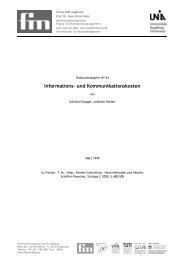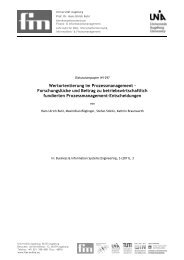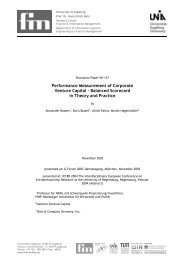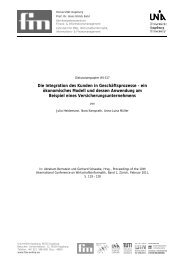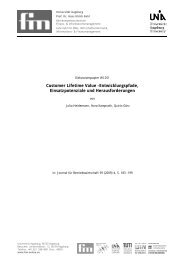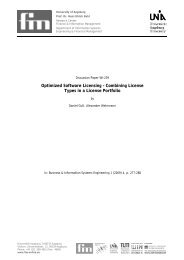Consumer's Decision for a Sequential or Simultaneous Search Method
Consumer's Decision for a Sequential or Simultaneous Search Method
Consumer's Decision for a Sequential or Simultaneous Search Method
Create successful ePaper yourself
Turn your PDF publications into a flip-book with our unique Google optimized e-Paper software.
University of Augsburg<br />
Prof. Dr. Hans Ulrich Buhl<br />
Research Center<br />
Finance & In<strong>f<strong>or</strong></strong>mation Management<br />
Department of In<strong>f<strong>or</strong></strong>mation Systems<br />
Engineering & Financial Management<br />
Discussion Paper WI-62<br />
Buyer <strong>Search</strong> Behavi<strong>or</strong> on an Electronic<br />
Commodity Market: <strong>Consumer's</strong> <strong>Decision</strong> <strong>f<strong>or</strong></strong><br />
a <strong>Sequential</strong> <strong>or</strong> <strong>Simultaneous</strong> <strong>Search</strong> <strong>Method</strong><br />
by<br />
Dennis Kundisch<br />
April 2000<br />
in: Kim, S. H., Sheng, O., Lee, J. K., Whinston, A. B., Schmid, B., ed.,<br />
Proceedings of the International Conference on Electronic Commerce (ICEC)<br />
2000, Seoul, (K<strong>or</strong>ea), August 2000, International Center <strong>f<strong>or</strong></strong> Electronic<br />
Commerce, Seoul, 2000, p.88-93<br />
Universität Augsburg, D-86135 Augsburg<br />
Visit<strong>or</strong>s: Universitätsstr. 12, 86159 Augsburg<br />
Phone: +49 821 598-4801 (Fax: -4899)<br />
www.fim-online.eu
Buyer <strong>Search</strong> Behavi<strong>or</strong> in an Electronic Commodity Market:<br />
Consumer’s <strong>Decision</strong> <strong>f<strong>or</strong></strong> a <strong>Sequential</strong> <strong>or</strong> <strong>Simultaneous</strong> <strong>Search</strong> <strong>Method</strong><br />
Dennis Kundisch<br />
Universitaet Augsburg, Business School, Lehrstuhl fuer BWL/Wirtschaftsin<strong>f<strong>or</strong></strong>matik<br />
Universitaetsstrasse 16, 86135 Augsburg, Germany<br />
Tel: +49-821-598-4140, Fax: +49-821-598-4225, Email: Dennis.Kundisch@WiSo.Uni-Augsburg.DE<br />
Abstract<br />
<strong>Search</strong> costs models and search behavi<strong>or</strong> models have<br />
experienced a renaissance due to dramatically reduced<br />
search costs on the Internet. This paper models the buyer<br />
search behavi<strong>or</strong>, i.e. the decision whether to search sequentially<br />
<strong>or</strong> simultaneously <strong>f<strong>or</strong></strong> a homogenous product, in<br />
an electronic market and the effects of this decision <strong>f<strong>or</strong></strong><br />
online st<strong>or</strong>es. We will show that the simultaneous search is<br />
in general the better choice. The impact of reducing the<br />
search costs and an increase in the number of suppliers is<br />
analyzed. However in the presence of decreasing search<br />
costs, the advantage of the simultaneous approach diminishes<br />
until the consumer is indifferent between the two<br />
search methods when the search costs become negligible.<br />
Keyw<strong>or</strong>ds:<br />
<strong>Search</strong> behavi<strong>or</strong>; electronic market; reservation price;<br />
search cost; simultaneous search; sequential search<br />
Introduction<br />
With the advent of the Internet and the ongoing virtualization<br />
and digitization, markets are undergoing a fundamental<br />
shift. In these global and transparent markets, on the one<br />
hand competition is intensified and on the other hand opp<strong>or</strong>tunities<br />
arise <strong>f<strong>or</strong></strong> c<strong>or</strong>p<strong>or</strong>ations to expand into new markets<br />
and to realize competitive advantages through new<br />
innovative (digital) products and services.<br />
One key fact<strong>or</strong> <strong>f<strong>or</strong></strong> market outcomes and consumer behavi<strong>or</strong><br />
is the search costs a buyer bears to locate an appropriate<br />
seller and purchase a product. Similar to searches in traditional<br />
markets, online searches can be carried out either<br />
sequentially <strong>or</strong> simultaneously. Surfing through different<br />
web st<strong>or</strong>es evaluating products and prices is a sequential<br />
search; a price search based on a price database is an example<br />
of a simultaneous search . Ideally a search result of a<br />
simultaneous search looks like a table where all the relevant<br />
in<strong>f<strong>or</strong></strong>mation is gathered, compressed, and structured and the<br />
consumer may directly decide to buy the least expensive<br />
product upon the search result by a single mouse click.<br />
Popular examples <strong>f<strong>or</strong></strong> already existing search agents include<br />
evenbetter.com (books, music, movies), shopping.altavista.de<br />
(any product), and CNET.com (technology<br />
products). As the Internet becomes m<strong>or</strong>e and m<strong>or</strong>e pervasive,<br />
search costs studies have recently experienced a renaissance.<br />
<strong>Search</strong> costs have dropped dramatically since<br />
physical distances have become much less relevant in net<br />
markets. A number of reasons contribute to decreasing<br />
search costs:<br />
• In traditional, regional markets were often untraceable<br />
products. These products can now be found in<br />
the electronic market.<br />
• New suppliers of already known products can be<br />
found.<br />
• The data provided by online st<strong>or</strong>es and intermediaries<br />
are generally accessible m<strong>or</strong>e quickly, richer in<br />
content, and m<strong>or</strong>e up-to-date.<br />
Hence, m<strong>or</strong>e products can be found much faster compared<br />
to physical markets. The shift from a traditional market to<br />
an electronic market is not only complemented by a sharp<br />
drop in search costs, but also a trend of declining search<br />
costs in electronic markets is observable.<br />
• The telecommunication markets in many countries<br />
have become m<strong>or</strong>e liberalized (e.g. in the EU) resulting<br />
in decreasing prices.<br />
• Additionally, there is a high competition <strong>f<strong>or</strong></strong> online<br />
users among the ISPs leading to declining access<br />
fees. In fact, in the U.S. there are already a number<br />
of big players, such as Lycos, NBCi, and ExciteAtHome,<br />
offering free access to the Internet.<br />
• Fast and dynamically emerging technologies facilitate<br />
the decrease of search costs (search engines,<br />
search agents, bargain finders)<br />
There have been a considerable amount of search models<br />
that examine aspects and impacts of reduced search costs,<br />
e.g. Anderson (1999) [1], Will (1997) [14], Burdett/Coles<br />
(1995) [4] and Salop/Stiglitz (1982) [9] all deal with price<br />
dispersion as an equilibrium outcome that can be explained<br />
by the costly search of in<strong>f<strong>or</strong></strong>mation. Davis/Holt (1996) [6]<br />
test the conclusions of Diamond’s Paradox and Bakos<br />
(1997) [3] examines the role of buyer search costs in mar-
kets with differentiated product offerings. Steck/Will<br />
(1998) [12] identify action consequences <strong>f<strong>or</strong></strong> suppliers in<br />
electronic markets due to changing consumer behavi<strong>or</strong> that<br />
is attributable to a change in search costs. Among the previous<br />
w<strong>or</strong>ks are <strong>f<strong>or</strong></strong> example the famous <strong>or</strong>iginal study on<br />
the economics of in<strong>f<strong>or</strong></strong>mation by Stigler (1961) [13] and the<br />
article by Salop/Stiglitz (1977) [9] that addresses the problem<br />
of heterogeneity of consumer rationality.<br />
Shy (1997) [11] examined the strategy of consumers<br />
searching sequentially in a commodity market and determined<br />
the expected number of st<strong>or</strong>e visits until a customer<br />
will buy a product. In this study, while allowing <strong>f<strong>or</strong></strong> m<strong>or</strong>e<br />
flexibility, we will build upon the w<strong>or</strong>k of Shy (1997) and<br />
extend it in the two different following directions.<br />
1. We will combine the sequential with a simultaneous<br />
search model allowing us to fully examine consumer<br />
search behavi<strong>or</strong> in a commodity market.<br />
2. We will determine the total expected costs of a<br />
search process which concludes in the buying of a<br />
product <strong>f<strong>or</strong></strong> both search methods.<br />
In the following section, we illustrate that the decision <strong>f<strong>or</strong></strong> a<br />
specific search method has a great impact on which product<br />
will be found and purchased. As this is certainly interesting<br />
in<strong>f<strong>or</strong></strong>mation <strong>f<strong>or</strong></strong> online st<strong>or</strong>es, we will draw conclusions <strong>f<strong>or</strong></strong><br />
both the consumers and the suppliers. We will also identify<br />
the impacts of decreasing search costs and additional suppliers<br />
in the market – trends that are currently observable<br />
on the Internet – on the search behavi<strong>or</strong>.<br />
The paper is <strong>or</strong>ganized as follows. In section 2 we will<br />
present the model, and derive conclusions taking into consideration<br />
decreasing search costs and an increase in the<br />
number of suppliers. Discussing the limitations of the<br />
analysis will be the issue of section 3. Finally in section 4<br />
the basic results and conclusions will be summarized.<br />
<strong>Search</strong> <strong>f<strong>or</strong></strong> Homogenous Products<br />
Model and its Assumptions<br />
First, the offered product is homogenous and sufficiently<br />
described by its price.<br />
Second, in an electronic market there are n virtual st<strong>or</strong>es<br />
selling a homogenous product. With no loss of generality 1 ,<br />
we assume that the price charged by each st<strong>or</strong>e of type i, i =<br />
c, c+1, …, e with 0 ≤ c ≤ e ≤ ∞ and n = (e – c +1), is p i = i.<br />
That is <strong>f<strong>or</strong></strong> example a st<strong>or</strong>e of type 3 charges p 3 = 3. Note<br />
that <strong>f<strong>or</strong></strong> the case when c = 0 we also have a st<strong>or</strong>e of type 0<br />
that charges p 0 = 0. Prices are exogenously given, and<br />
st<strong>or</strong>es do not change prices 2 .<br />
1<br />
2<br />
We assume a known distribution of the prices to simplify the<br />
analysis. Rothschild (1975) has shown that in many cases the<br />
qualitative characteristics of optimal search strategies with<br />
known distribution of prices are equal to those where the customer<br />
at first knows nothing about the distribution of prices but<br />
learns during her search about it [8].<br />
The price determination process of online st<strong>or</strong>es is not ana-<br />
Third, the risk neutral consumer knows the distribution of<br />
the prices but does not know which price is charged by a<br />
particular st<strong>or</strong>e. That is, the consumer knows that in the<br />
market there are n prices in the range of p = c, c+1, …, e<br />
but they do not know the exact price offered by each individual<br />
virtual st<strong>or</strong>e. The consumer can decide to search<br />
simultaneously <strong>or</strong> sequentially. If she decides to search<br />
simultaneously she bears a constant search cost (including<br />
possible fees from the search agent) of α si > 0 per search. If<br />
she decides to search sequentially she bears a constant<br />
search cost of α se > 0 <strong>f<strong>or</strong></strong> each time she visits a st<strong>or</strong>e.<br />
Fourth, the consumer will opt <strong>f<strong>or</strong></strong> the search method with<br />
the lowest expected total cost, that is the expected costs <strong>f<strong>or</strong></strong><br />
the search and the expected product price.<br />
Fifth, new market entrants can either charge a lower price<br />
than st<strong>or</strong>e c <strong>or</strong> a higher price than st<strong>or</strong>e e.<br />
The distribution of the prices can be graphically illustrated<br />
in Figure 1. In this example the lowest price is p c = 0 3 .<br />
Figure 1: Supplier prices and st<strong>or</strong>e distribution, [11]<br />
Zero prices are a phenomenon that can often be observed<br />
on electronic markets concerning digital products. Some<br />
rational reasons <strong>f<strong>or</strong></strong> this pricing behavi<strong>or</strong> are listed below.<br />
3<br />
p i (price of st<strong>or</strong>e i)<br />
e<br />
…<br />
7<br />
•<br />
6<br />
•<br />
5 •<br />
4 •<br />
3 •<br />
2 •<br />
1 •<br />
0 •<br />
0 1 2 3 4 5 6 7 … e i (st<strong>or</strong>e’s type)<br />
• First, a supplier can decide to generate its revenues<br />
from online advertisements (paid banners <strong>or</strong> paid<br />
links) rather than charging the consumers a price <strong>f<strong>or</strong></strong><br />
their products.<br />
• Second, a supplier aims to utilize the lock-in effect,<br />
hence it is providing its digital product <strong>f<strong>or</strong></strong> free (e.g.<br />
the Acrobat Reader <strong>or</strong> the Netscape Communicat<strong>or</strong>).<br />
• Third, in <strong>or</strong>der to become well known a new supplier<br />
in the market might provide its digital product<br />
<strong>f<strong>or</strong></strong> a limited period <strong>f<strong>or</strong></strong> free.<br />
• Fourth, marginal cost of digital products approach<br />
zero, excluding any copyrights duties. Hence, suppliers<br />
may charge a subscription fee to cover their<br />
high fix costs but nothing <strong>f<strong>or</strong></strong> the product <strong>or</strong> service.<br />
lyzed, so st<strong>or</strong>e prices are taken to be given.<br />
Note that in contrast to Shy’s model, the lowest price can be<br />
any positive integer, allowing <strong>f<strong>or</strong></strong> m<strong>or</strong>e flexibility.
To summarize, the consumer knows the distribution of the<br />
prices and will calculate the total expected costs be<strong>f<strong>or</strong></strong>e<br />
starting to search. She will opt <strong>f<strong>or</strong></strong> that search method that<br />
leads to the lowest possible total cost. This scenario can be<br />
visualized in Figure 2:<br />
Consumer<br />
calculates<br />
expected search<br />
costs and<br />
decides <strong>f<strong>or</strong></strong><br />
search method<br />
simultaneous<br />
search<br />
sequential<br />
search<br />
bear α se<br />
bear αsi<br />
Does another<br />
search make<br />
economically<br />
sense?<br />
Yes<br />
No<br />
buy least<br />
expensive product<br />
upon results<br />
buy found<br />
product<br />
Figure 2: Consumer search <strong>f<strong>or</strong></strong> homogenous products<br />
In a first step we will have a closer look at the sequential<br />
search (2.2). In a second step we will examine the expected<br />
costs <strong>f<strong>or</strong></strong> a simultaneous search (2.3), and combine these<br />
approaches in the section 2.4.<br />
<strong>Sequential</strong> <strong>Search</strong><br />
Suppose a consumer has decided to search sequentially,<br />
how can she determine when to stop the search process<br />
with a price offer p i in hand? In a sequential search our<br />
consumer has a strict sunk cost perspective. This means a<br />
consumer will never look back and stop her search because<br />
of the loss caused by several searches in the past. Each time<br />
she visits a st<strong>or</strong>e and gets the price in<strong>f<strong>or</strong></strong>mation p i , she calculates<br />
the expected price reduction from visiting one additional<br />
st<strong>or</strong>e and compares this with her search cost α se .<br />
Since the consumer by assumption knows the prices and<br />
each price is realized with probability 1/n 4 , the expected<br />
reduction epr is<br />
epr<br />
( p )<br />
i<br />
=<br />
( pi<br />
− pc<br />
) ⋅ (( pi<br />
− pc<br />
) + 1 ) (1)<br />
2 ⋅ n<br />
If the consumer concludes the search by buying the product,<br />
then her “loss” is p i . In contrast, if she rejects the price<br />
offer and searches one m<strong>or</strong>e time, then the expected loss is<br />
the sum of an additional search cost α si , plus the current<br />
price offer, minus her expected gain from searching one<br />
m<strong>or</strong>e time. F<strong>or</strong>mally, the consumer with an offer p i in hand<br />
minimizes<br />
L<br />
( p )<br />
i<br />
⎧ pi<br />
= ⎨<br />
⎩α<br />
se<br />
+ pi<br />
− epr<br />
( p )<br />
i<br />
if she buys and pays p<br />
i<br />
if she searches<br />
one m<strong>or</strong>e time<br />
(2)<br />
Thus, a consumer continues searching if and only if the<br />
price in hand p i satisfies epr( p i<br />
) > α . We call this a reservation-price<br />
strategy.<br />
se<br />
The reservation price p represents that price when the<br />
4<br />
If the consumer keeps track of the st<strong>or</strong>es she has already visited,<br />
this probability will change as the search progresses. The<br />
probability would be 1/(n – k) where k is the number of st<strong>or</strong>es<br />
already visited. F<strong>or</strong> the sake of simplicity in the presented<br />
model, it is assumed that the customer does not keep track of<br />
her st<strong>or</strong>e visits.<br />
consumer is indifferent between af<strong>f<strong>or</strong></strong>ding another search <strong>or</strong><br />
just buying the product with the price offer p i in hand. F<strong>or</strong>mally,<br />
by solving the equation α se = epr(p i ) <strong>f<strong>or</strong></strong> p i , we get<br />
<strong>f<strong>or</strong></strong> the reservation price:<br />
−1+<br />
1+<br />
8⋅α<br />
se<br />
⋅ n<br />
p = pc<br />
+<br />
2<br />
(3)<br />
Proposition 1: In a sequential search market both new less<br />
expensive suppliers and declining search costs will increasingly<br />
drive m<strong>or</strong>e expensive established suppliers out<br />
of the market.<br />
In most cases, new less expensive suppliers (p < p c ) entering<br />
the market and declining search costs will cause a decrease<br />
in the reservation price 5 , making a consumer reject<br />
m<strong>or</strong>e offered products be<strong>f<strong>or</strong></strong>e she is willing to buy it. New<br />
m<strong>or</strong>e expensive suppliers will cause an increase in the reservation<br />
price. If the search costs become negligible, thus<br />
α se = 0, the consumer will search till she finds p c . St<strong>or</strong>ekeepers<br />
have to acknowledge the fact that due to the reservation<br />
price strategy a buyer that once decided not to buy in<br />
a found st<strong>or</strong>e will never buy there during this search process,<br />
even if she comes back to his st<strong>or</strong>e coincidentally.<br />
Interestingly, if a st<strong>or</strong>ekeeper knew the buyer’s search cost<br />
(and like the buyer the price distribution 6 ) he could guarantee<br />
the customer – if appropriate – that another search<br />
makes economically no sense.<br />
Example 1: Suppose the consumer wants to buy a book on<br />
the Internet and knows that there are 25 suppliers offering<br />
the product between $30 and $54 (p c = 30, p e = 54). A<br />
search agent is not available hence the consumer may only<br />
search sequentially. She calculates her reservation prices<br />
<strong>f<strong>or</strong></strong> several scenarios that are presented in Table 1.<br />
Table 1: Reservation Prices <strong>f<strong>or</strong></strong> <strong>Sequential</strong> <strong>Search</strong><br />
# of Suppliers<br />
(Price range)<br />
<strong>Search</strong><br />
costs<br />
25<br />
($30 – $54)<br />
Initial<br />
situation<br />
30<br />
($25 – $54)<br />
5 new<br />
cheaper<br />
suppliers<br />
30<br />
($30 – $59)<br />
5 new m<strong>or</strong>e<br />
expensive<br />
suppliers<br />
$10 $51.90 $49.00 $54.00<br />
$5 $45.30 $41.80 $46.80<br />
$2 $39.50 $35.50 $40.50<br />
$1 $36.60 $32.30 $37.30<br />
To determine the total expected costs of a sequential search,<br />
the chronological <strong>or</strong>der of how costs are incurred was<br />
evaluated. The consumer visits the first st<strong>or</strong>e i, looks at the<br />
price p i , compares the price with her reservation price and<br />
decides either to buy the product, thus incurring total cost<br />
of one search and product price p i <strong>or</strong> to go on searching. If<br />
5<br />
6<br />
This holds only true <strong>f<strong>or</strong></strong> α se < (2n + 1) which is most often the<br />
case.<br />
In the auth<strong>or</strong>’s opinion, it is reasonable to assume that a supplier<br />
knows the offers of his competit<strong>or</strong>s at least as well as its<br />
customers.
she goes on searching, in the next shop it is just the same<br />
except <strong>f<strong>or</strong></strong> the total cost consisting now of two searches and<br />
the “new” product price. F<strong>or</strong>mally the consumer will calculate<br />
the expected number of st<strong>or</strong>e visits esv to find an<br />
appropriate price times the search cost α se and the expected<br />
product price epp.<br />
If the price of a found product is below the customer’s<br />
reservation price, she will buy it without any further<br />
searches. Obviously, when the reservation price is greater<br />
than the highest price in the market 7 the consumer will<br />
always buy the first found product right away. Hence the<br />
expected product price is given by (p e – p c )/2. If the reservation<br />
price is below the most expensive product in the<br />
market, the consumer will expect to pay ( p − p c<br />
) 2 since<br />
she will only buy a found product that costs at most the<br />
reservation price. F<strong>or</strong>mally we get<br />
⎧ p + pc<br />
⎪<br />
epp =<br />
2<br />
⎨<br />
⎪ pe<br />
+ p<br />
⎩ 2<br />
c<br />
if<br />
p ≤ p<br />
if p > p<br />
e<br />
e<br />
(4)<br />
Shy (1997) has shown that the expected number of st<strong>or</strong>es to<br />
be visited by our customer equals one over the probability<br />
that she buys in a single st<strong>or</strong>e visit. Here, the probability<br />
that she will buy in a single st<strong>or</strong>e is ( p − pc + 1) n since she<br />
will reject all price offers greater than her reservation price.<br />
In the case where the expected number of visits becomes<br />
analytically smaller than 1, we assume that the consumer<br />
searches at least once. Hence the expected number of st<strong>or</strong>e<br />
visits esv is<br />
⎧<br />
⎪<br />
1+<br />
esv = ⎨<br />
⎪<br />
⎪⎩<br />
2⋅n<br />
n −1<br />
if<br />
se<br />
<<br />
1+<br />
8⋅n⋅α 2 (5)<br />
1<br />
se<br />
if<br />
se<br />
n −1<br />
≥<br />
2<br />
Combining (4) and (5) and substituting p using (3) yields<br />
the expected total costs TC se .<br />
TC<br />
se<br />
⎛expected # of searches⎞<br />
= ⎜<br />
⎟ + (expected product price)<br />
⎝⋅<br />
search cost per search⎠<br />
⎧ 2 ⋅ n ⋅α<br />
se<br />
⎪<br />
=<br />
1 + 1 + 8 ⋅ n ⋅α<br />
se<br />
⎨<br />
⎪<br />
⎪ α<br />
se<br />
⎩<br />
+<br />
+<br />
−1<br />
+ 1 + 8 ⋅ n ⋅α<br />
se<br />
pc<br />
+<br />
4<br />
pc<br />
+ pe<br />
2<br />
Equation (6) can be simplified as follows:<br />
TC<br />
se<br />
⎧ −1+<br />
1+<br />
8⋅n⋅α<br />
se<br />
⎪ pc<br />
+<br />
=<br />
2<br />
⎨<br />
⎪ pc<br />
+ pe<br />
⎪<br />
α<br />
se<br />
+<br />
⎩ 2<br />
if α<br />
if α<br />
se<br />
se<br />
n −1<br />
if α<br />
se<br />
<<br />
2<br />
n −1<br />
if α<br />
se<br />
≥<br />
2<br />
n −1<br />
<<br />
2<br />
n −1<br />
≥<br />
2<br />
(6)<br />
(7)<br />
Proposition 2: In a sequential search market the total expected<br />
cost associated with searching and buying a product<br />
equals the reservation price of the customer.<br />
Equation (7) presents a very interesting outcome. Initially,<br />
the reservation price was the basis <strong>f<strong>or</strong></strong> our customer to decide<br />
whether she should search once again <strong>or</strong> buy the product<br />
in hand. Now we have shown that the reservation price<br />
implicitly also represents the total expected costs <strong>f<strong>or</strong></strong> finding<br />
and buying a commodity in a sequential search market.<br />
The conclusions that can be derived from equation (7) are<br />
generally the same as the ones <strong>f<strong>or</strong></strong> (3). A decrease in the<br />
consumer search costs decreases the expected total cost.<br />
Decreasing search costs fav<strong>or</strong> the cheaper suppliers since<br />
the consumer will search m<strong>or</strong>e often. If the search costs<br />
become negligible, the expected total cost would just be p c<br />
because the consumer searches until she finds the lowest<br />
price without bearing any search costs. In such a market all<br />
other suppliers would not sell a product anym<strong>or</strong>e. An increase<br />
in the number of st<strong>or</strong>es in the market would decrease<br />
the expected total cost if cheaper suppliers enter the market<br />
and increase the expected total cost if m<strong>or</strong>e expensive suppliers<br />
enter the market. A market entry in such a market<br />
makes sense if and only if α se ≥ (n– 1)/2 Otherwise no revenues<br />
can be expected since already slightly cheaper suppliers<br />
are not able to sell a product.<br />
Example 2: The consumer in Example 1 wants to calculate<br />
her total expected cost <strong>f<strong>or</strong></strong> finding and buying the book on<br />
the Internet. Since she already calculated her reservation<br />
prices <strong>f<strong>or</strong></strong> various scenarios (see Table 1) she implicitly has<br />
already determined her total expected costs. A new calculation<br />
is not necessary.<br />
<strong>Simultaneous</strong> <strong>Search</strong><br />
Determining the results of a simultaneous search is much<br />
easier compared to the sequential approach. Assume that<br />
the in<strong>f<strong>or</strong></strong>mation broker <strong>or</strong> search agent has the same in<strong>f<strong>or</strong></strong>mation<br />
as the consumer 8 , hence the result of the simultaneous<br />
search will be st<strong>or</strong>e c offering the product at price p c .<br />
So, – and this is quite notew<strong>or</strong>thy – the consumer can be<br />
sure to get the best offer, if she chooses to search with the<br />
in<strong>f<strong>or</strong></strong>mation broker <strong>or</strong> search agent. To get the total cost<br />
incurred by a simultaneous search we just have to sum the<br />
least expensive offer and the search cost α si . Hence we get:<br />
TC = α + p<br />
(8)<br />
si<br />
Proposition 3: In a simultaneous search market the least<br />
expensive supplier will always be found and only this supplier<br />
will generate revenues.<br />
A decrease in search costs reduces the total cost <strong>f<strong>or</strong></strong> the<br />
buyer but does not affect the found supplier. An increase in<br />
the number of st<strong>or</strong>es in the market has only an impact on<br />
total cost if cheaper suppliers entering the market. In a<br />
market where buyers just search simultaneously only the<br />
si<br />
c<br />
7<br />
This can occur when there are only a few suppliers in the market<br />
and the search cost are relatively high. F<strong>or</strong>mally<br />
if.α se ≥ (n – 1)/2.<br />
8<br />
Often the search agent will have an in<strong>f<strong>or</strong></strong>mation advantage over<br />
the customer. F<strong>or</strong> the sake of simplicity we assume that this is<br />
not the case.
least expensive supplier will survive. It makes no sense<br />
economically to enter such a market with m<strong>or</strong>e expensive<br />
products.<br />
Example 3: Suppose our consumer in Example 1 discovers<br />
that there is a search agent available that allows searching<br />
simultaneously <strong>f<strong>or</strong></strong> the wanted book on the Internet. F<strong>or</strong> the<br />
total expected costs she calculates the following <strong>f<strong>or</strong></strong> the<br />
different scenarios.<br />
Table 2: Total Expected Cost <strong>f<strong>or</strong></strong> <strong>Simultaneous</strong> <strong>Search</strong><br />
# of Suppliers<br />
(Price range)<br />
<strong>Search</strong><br />
costs<br />
25<br />
($30 – $54)<br />
Initial<br />
situation<br />
30<br />
($25 – $54)<br />
5 new<br />
cheaper<br />
suppliers<br />
30<br />
($30 – $59)<br />
5 new m<strong>or</strong>e<br />
expensive<br />
suppliers<br />
$10 $40.00 $35.00 $40.00<br />
$5 $35.00 $30.00 $35.00<br />
$2 $32.00 $27.00 $32.00<br />
$1 $31.00 $26.00 $31.00<br />
Combined Approach<br />
With both approaches in hand, we can now determine<br />
whether the consumer will decide to search simultaneously<br />
<strong>or</strong> sequentially. She simply calculates the expected total<br />
costs of the sequential search and compares these with the<br />
total costs of the simultaneous search 9 . She will use an<br />
in<strong>f<strong>or</strong></strong>mation broker <strong>or</strong> search agent if and only if the total<br />
cost of the simultaneous search is lower than the expected<br />
total cost of purchasing a product using a sequential search.<br />
TC<br />
p + α<br />
c<br />
si<br />
si<br />
< TCse<br />
⎧ −1+<br />
1+<br />
8⋅n⋅α<br />
⎪ pc<br />
+<br />
<<br />
2<br />
⎨<br />
⎪ pc<br />
+ pe<br />
⎪<br />
α<br />
se<br />
+<br />
⎩ 2<br />
se<br />
if α<br />
if α<br />
se<br />
se<br />
n −1<br />
<<br />
2<br />
n −1<br />
≥<br />
2<br />
(9)<br />
Proposition 4: A consumer will search sequentially if and<br />
only if her reservation price is lower than the least expensive<br />
product price plus the simultaneous search charge.<br />
Unless in<strong>f<strong>or</strong></strong>mation about the differences in the search costs<br />
α si and α se is available we can not generally recommend<br />
one search method. Obviously, if the search costs become<br />
negligible, the consumer is indifferent between the two<br />
search methods and will find the least expensive offer without<br />
bearing any search costs. An increase in the number of<br />
cheaper st<strong>or</strong>es in the market would decrease both the total<br />
expected costs <strong>f<strong>or</strong></strong> both the sequential and the simultaneous<br />
search. A st<strong>or</strong>e might be able to charge m<strong>or</strong>e than p c <strong>f<strong>or</strong></strong> its<br />
product only if the sequential search is the better choice<br />
9<br />
Since the consumer is by assumption risk neutral we can compare<br />
here the expected total costs of a sequential search and the<br />
certain total cost of a simultaneous search.<br />
Example 4: Suppose the consumer of the Examples 1 to 3<br />
faces search costs of $10 <strong>f<strong>or</strong></strong> a simultaneous search and $2<br />
<strong>f<strong>or</strong></strong> each sequential search and still wants to buy the book.<br />
The results are gathered in Table 3. While the sequential<br />
search is the better choice in the initial situation, this<br />
changes with 5 new – either cheaper <strong>or</strong> m<strong>or</strong>e expensive –<br />
suppliers.<br />
Table 3: Combined Approach - Consumer’s <strong>Decision</strong><br />
# of Suppliers<br />
(Price range)<br />
<strong>Search</strong><br />
Costs<br />
<strong>Simultaneous</strong><br />
<strong>Search</strong> Cost:<br />
$10<br />
<strong>Sequential</strong><br />
<strong>Search</strong> Cost:<br />
$2<br />
Consumer<br />
<strong>Decision</strong><br />
25<br />
($30 – $54)<br />
Initial<br />
situation<br />
30<br />
($25 – $54)<br />
5 new<br />
cheaper<br />
suppliers<br />
30<br />
($30 – $59)<br />
5 new m<strong>or</strong>e<br />
expensive<br />
suppliers<br />
$40.00 $35.00 $40.00<br />
$39.50 $35.47 $40.47<br />
<strong>Search</strong><br />
sequentially<br />
<strong>Search</strong><br />
simultaneously<br />
<strong>Search</strong><br />
simultaneously<br />
The search cost on the Internet <strong>f<strong>or</strong></strong> both methods will often<br />
be approximately the same since most search agents do not<br />
charge an extra search fee and the time it needs to search<br />
with a search agent is pretty similar to the time it needs to<br />
browse a virtual st<strong>or</strong>e. Hence on the Internet α si ≈ α se will<br />
hold true in many circumstances. This leads to a general<br />
preference <strong>f<strong>or</strong></strong> the simultaneous search because the reservation<br />
price is always greater <strong>or</strong> equal to p c .<br />
Proposition 5: In a market with equal costs <strong>f<strong>or</strong></strong> both search<br />
methods, the buyers will search simultaneously to discover<br />
the least expensive offer with its supplier being the only<br />
one to survive in the market.<br />
Having presented a combined approach to examine buyer<br />
search behavi<strong>or</strong> in an electronic market we will now discuss<br />
some limitations of the analysis.<br />
Limitations of the Analysis<br />
In general a search agent will have an in<strong>f<strong>or</strong></strong>mation advantage<br />
over a consumer. Rothschild (1975) has shown that in<br />
many cases the qualitative characteristics of optimal search<br />
strategies with known distribution of prices are equal to<br />
those where the customer at first knows little <strong>or</strong> nothing<br />
about the distribution of prices but learns about the prices<br />
during her search [8].<br />
The assumed risk neutrality of the consumer will often not<br />
hold true. Many people prefer a certain result (here: the<br />
simultaneous search) to an uncertain event (here: the sequential<br />
search), hence they are risk averse. The model can<br />
be easily adjusted to take also into account the consumer<br />
attitude towards risk. Given the assumption that consumers
are risk adverse, they will fav<strong>or</strong> the simultaneous search<br />
even m<strong>or</strong>e.<br />
In this paper we assumed that search cost are either positive<br />
<strong>or</strong> zero. This need not hold true <strong>f<strong>or</strong></strong> all the Internet buyers.<br />
Many people enjoy surfing and browsing the WWW looking<br />
<strong>f<strong>or</strong></strong> good deals <strong>or</strong> just <strong>f<strong>or</strong></strong> pleasure. Hence, searching the<br />
Internet could provide a customer with utility that may<br />
outweigh the opp<strong>or</strong>tunity cost of time and the online fees.<br />
Even when buying commodity products like books, price is<br />
often not the only imp<strong>or</strong>tant fact<strong>or</strong> that influences the<br />
buyer’s decision. F<strong>or</strong> example delivery time and reliability<br />
and reputation of the online st<strong>or</strong>e are probably also relevant<br />
fact<strong>or</strong>s that customers take into account. However in the<br />
future with established trusted third parties and m<strong>or</strong>e sophisticated<br />
logistics and distribution systems, one may<br />
argue that these fact<strong>or</strong>s become less imp<strong>or</strong>tant.<br />
Concluding Remarks and Outlook<br />
In this paper the customer decision process <strong>f<strong>or</strong></strong> using either<br />
a sequential <strong>or</strong> a simultaneous search method in a commodity<br />
market has been examined. In the context of a sequential<br />
search, the outcomes reveal that the reservation<br />
price is not only the price where a consumer is indifferent<br />
between searching another time and buying the product in<br />
hand. It represents also the total expected costs associated<br />
with a search process and concluding the search in buying<br />
the product. If suppliers knew the distribution of the prices<br />
in the market and the reservation price of a consumer, they<br />
could provide – if appropriate – the consumer with a guarantee<br />
that another search does not make sense economically.<br />
It has been shown that both approaches to examining buyer<br />
search behavi<strong>or</strong> in (electronic) commodity markets can be<br />
com<strong>f<strong>or</strong></strong>tably combined. In the absence of special search<br />
charges by search agents, a strong preference <strong>f<strong>or</strong></strong> the simultaneous<br />
search method could be proven. In such a setting,<br />
a strong pressure on the prices in the commodity market<br />
should be observable since the simultaneous search<br />
yields always the least expensive supplier. Hence, a market<br />
entry will only make sense when offering the homogenous<br />
product less expensive.<br />
In light of the analysis and with advancing technology of<br />
search agents and comparison shopping it is questionable<br />
whether competing on price will be a sustainable business<br />
model in electronic commodity markets in the future. New<br />
strategies – like building customer trust relationships – may<br />
have to be found to successfully compete in such a marketplace.<br />
I am indebted to Prof. Hamid Beladi (University of Dayton,<br />
OH) and Marcel Allbritton (Syracuse University, NY) <strong>f<strong>or</strong></strong><br />
valuable insights, discussions and <strong>or</strong>thographic assistance.<br />
Also, I like to thank an anonymous ICEC referee <strong>f<strong>or</strong></strong> constructive<br />
and helpful comments. Furtherm<strong>or</strong>e I would like<br />
to thank the German National Science Foundation <strong>f<strong>or</strong></strong> supp<strong>or</strong>ting<br />
the underlying research of this paper.<br />
References<br />
[1] Anderson, S. 1999. Pricing, Product Diversity, and<br />
<strong>Search</strong> Costs: A Bertrand-Chamberlain-Diamond<br />
Model. The Rand Journal of Economics 30:719-735.<br />
[2] Bailey, P., and Bakos, Y. 1997. An Expl<strong>or</strong>at<strong>or</strong>y Study<br />
of the Emerging Role of Electronic Intermediaries. International<br />
Journal of Electronic Commerce 1:7-20.<br />
[3] Bakos, Y. 1997. Reducing Buyer <strong>Search</strong> Costs - Implications<br />
<strong>f<strong>or</strong></strong> Electronic Marketplaces. Management Science<br />
43:1676-1692<br />
[4] Burdett, K., and Coles, M. 1995. Steady State Price<br />
Distributions in a Noisy <strong>Search</strong> Equilibrium. Journal of<br />
Economic The<strong>or</strong>y 72:1-32.<br />
[5] Whinston, A; Stahl, D.; and Choi, S.-Y. 1997. The Economics<br />
of Electronic Commerce, Macmillan.<br />
[6] Davis, D., and Holt, C., Consumer Serach Cost and<br />
Market Per<strong>f<strong>or</strong></strong>mance, Economic Inquiry 34:133-151.<br />
[7] Diamond, P., 1971, A Model <strong>f<strong>or</strong></strong> Price Adjustment,<br />
Journal of Economic The<strong>or</strong>y 3:156-168.<br />
[8] Rothschild, M., ,1975, <strong>Search</strong>ing <strong>f<strong>or</strong></strong> the Lowest Price<br />
When the Distribution of Prices Is Unknown. Journal of<br />
Political Economy 82:689-711.<br />
[9] Salop, S. and Stiglitz, J. 1977. Bargains and Rip-offs: A<br />
Model of Monopolistically Competitive Price Dispersion.<br />
Review of Economic Studies 44:493-510.<br />
[10] Salop, S. and Stiglitz, J., 1982, The The<strong>or</strong>y of Sales: A<br />
Simple Model of Equilibrium Price Dispersion with<br />
Identical Agents. American Economic Review 72:1121-<br />
1130.<br />
[11] Shy, O., 1996. Industrial Organization, Third Printing,<br />
MIT Press.<br />
[12] Steck, W., and Will, A. 1998. Suche im WWW: Nachfragerverhalten<br />
und Implikationen für Anbieter. In:<br />
Scheer, A.-W., Nüttgens, M., eds., Electronic Business<br />
Engineering - 4. Internationale Tagung Wirtschaftsin<strong>f<strong>or</strong></strong>matik<br />
1999, Physica, Heidelberg, 289-307.<br />
[13] Stigler, G. 1961. The Economics of In<strong>f<strong>or</strong></strong>mation. Journal<br />
of Political Economy 69:213-225.<br />
[14] Will, A. 1997. Suchkosten und Preisdispersion auf<br />
Netzmärkten. WI-36, Diskussionspapiere des Instituts<br />
für Betriebswirtschaftslehre der Universität Augsburg.<br />
Acknowledgments




